“Petrarchism is a chronic disease of Italian literature,” wrote Arturo Graf at the beginning of one of his memorable essays in 1888: and the sixteenth century is “the century in which Petrarchism floats, luxuriates, triumphs and overflows.” It is difficult, however, to reason as to why, precisely in the sixteenth century, such a vast, pervasive and widespread interest in Petrarch’s poetry spread: there were those who, believing the sentiment oflove to be the only one on which one could freely poet in an age when the Church’s control over cultural production was rigid, argued that Petrarch was an essentially obligatory choice. Some locate in the theoretical work of Pietro Bembo, a Petrarchist himself (and, indeed, according to Contini an inaugurator of the “season of an unbetrayed Petrarch”), who proposed a sort of canon for the classification of literary genres, the spark that inflamed all of Italy (and not only) with love for the poet laureate. Some others believe that Petrarchism arose in the wake of the spread of rhyming books more or less exemplified on the model of the Canzoniere. Whichever way you look at it, this is one of the most complex phenomena in the history of Italian literature, and it is difficult to summarize its roots in a few lines, but it is functional to offer a context for understanding how the widespread imitation of Petrarchan poetry (a fact of European scope, in the furrow of which great literati but also legions of mediocrities entered, moved by the fact that, lacking brilliant genius, they had no other means to poetize than that of imitation), at a certain point in history, found a wide, multiform and fierce resistance.
Therefore, if we were to search for a literary antecedent that could motivate the interesting sequence of works that art historians Barbara Furlotti, Guido Rebecchini and Linda Wolk-Simon have assembled for the exhibition Giulio Romano. Art and Desire (in Mantua, Palazzo Te, from October 6, 2019 to January 6, 2020), we would be at ease to find parallels in the vast anti-Petrarchist movement that animated several courts in Italy and that, in the Mantua of the Gonzagas, had its two main exponents in Teofilo Folengo (Mantua, 1491 - Campese, 1544) and Pietro Aretino (Arezzo, 1492 - Venice, 1556): if the desecratory vein of the former was expressed in the sphere of lyric poetry, that of the latter found instead an outlet in lyricism on the subject of love. To that pure, elevated, ethereal, ecstatic, spiritual, contemplative love sung by the Petrarchans was opposed that which intellectuals and philosophers, at least from humanism onward, had placed on the lowest rung of the ladder of affective feelings for another person, namely what Graf calls “practical love,” that which is “sensual and brutal, without modesty and without veil, love that is nothing now but a lushness and a rush of animal appetites, the instinct that lashes out and overpowers.” And it was precisely on this sensual and brutal love (“brutal,” of course, to be understood in the positive meaning of the term: a primitive, visceral, instinctive, impetuous, irrational love) that the sixteenth century would produce some of its greatest masterpieces, in literature (Aretino in primis) as in art.
Then there are further, relevant cultural aspects to take due account of: consider the fact that the typically Renaissance revaluation of everything that falls within the realm ofsensory experience could not fail to lead also to an investigation of the more trivial aspects of the world of the senses (“in this context,” wrote scholar Mary Pardo, “the depiction of erotic subjects became almost a way of testing the sensory ’truth’ of the work of art,” in the sense that “the work of art, being capable of becoming an instrument of courtship between the author and the viewer, was also believed to be capable of illuminating the psychic mechanisms of erotic attraction.”) Related to some extent to this theme is the fact that several literati decided to confer artistic dignity on those who were usually marginalized or excluded tout court from any artistic and literary product: it will be worth mentioning at least the harlots who crowd the comedies of Pietro Aretino and Ludovico Ariosto or the novellas of Matteo Bandello. Again, it will be worth remembering how in the early sixteenth century, as Linda Wolk-Simon also writes in the catalog, “the boundary between sacred and profane was less clear and the religious images produced in Rome in this period often contained overtly erotic allusions” (a situation that only the Council of Trent would put in order), and how the inquisitive attitude of 16th-century antiquarian culture had made possible an all-encompassing approach to the objects that, increasingly copiously, were being found underground in Rome and, more generally, in the centers that had enjoyed an illustrious Roman past: the eroticism emanating from many ancient works therefore became an object of study and a source of inspiration for many artists.
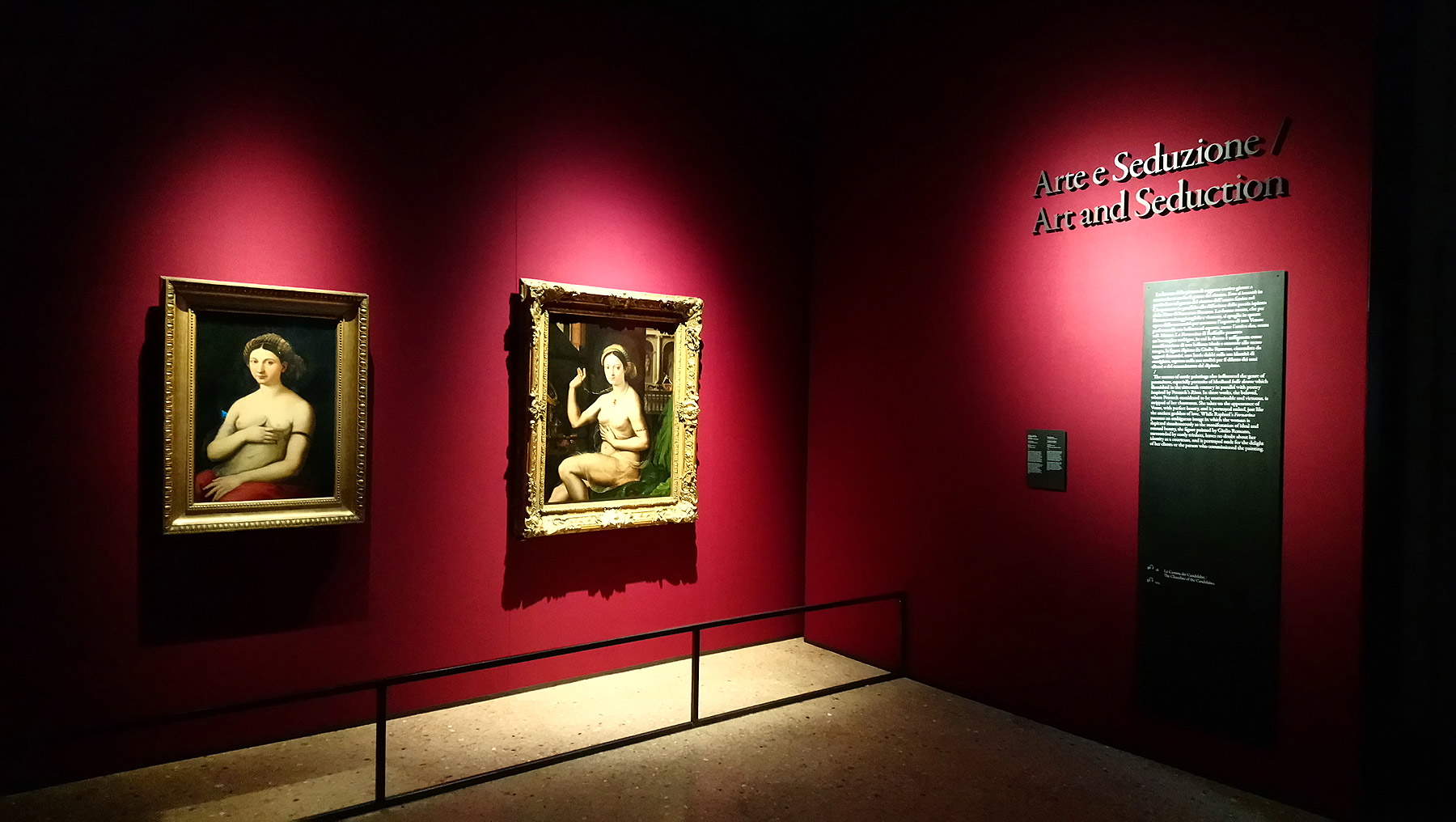 |
| Hall of the exhibition Giulio Romano. Art and Desire |
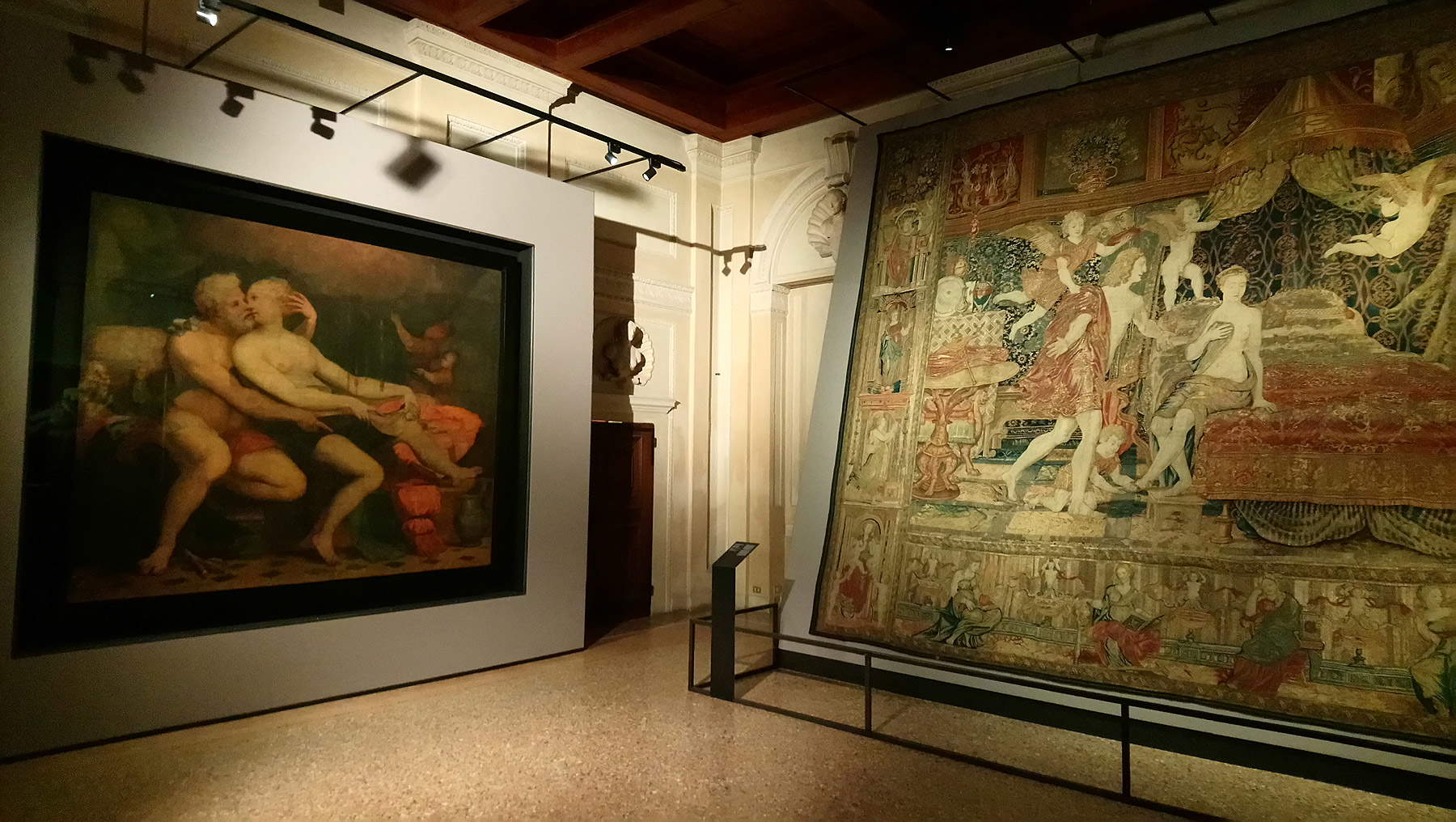 |
| Hall of the exhibition Giulio Romano. Art and Desire |
It is precisely with the ancient that the exhibition itinerary opens: the Venus Genetrix on loan from the Kunsthistorisches Museum in Vienna (and well known to the artists operating in Rome at the dawn of the 16th century) serves almost as an introibo in order to inform the public about the images that had to inspire and shape the erotic imagery of the artists of the time, including those who, in Rome, frequented the workshop of Raphael Sanzio (Urbino, 1483 - Rome, 1520), a place where many of these cues found fertile ground to grow and mature, since the Urbino artist worked for various patrons capable of liking the reworking (even in a blatantly explicit key) of motifs and images that came from the ancient world. Among Raphael’s cultured clients was Cardinal Bernardo Dovizi da Bib biena (Bibbiena, 1470 - 1520), a personality who, despite wearing the robes of a prelate, was the originator of one of the most exemplary cases of eroticism in painting at the beginning of the 16th century: the exhibition, consequently, dedicates a room to this important affair, which dates back to 1516, when the cardinal commissioned Raphael to decorate a bathroom stanzino (a “little stove,” as the small room is universally known: it owes its name to the fact that it was a small but well-heated room) with old-fashioned scenes. The panels that decorate the room narrate the love affairs of the goddess Venus, according to stylistic formulas whose origins are to be found in the wall painting of ancient Rome, which Renaissance painters had recently begun to study and appreciate.
There was, however, an exact correspondence with ancient painting on the thematic level as well: for example, the Venus anadiomene, or Venus rising from the water, recalls the fresco that Pliny the Elder, in his Naturalis historia, included in the list of masterpieces of the Greek painter Apelles (“Among his works,” Pliny wrote, "it is not easy to say which are the most beautiful: the divine Augustus dedicated a Venus coming out of the sea in the temple of Caesar his father, and this Venus is called anadyomene"), and likewise the Venus with the satyr may have been inspired by reading some ancient fable, as were the other episodes in the cycle, largely taken from Ovid’s Metamorphoses. Brought into the exhibition are a number of engravings that Marcantonio Raimondi (San Martino in Argine, c. 1479 - 1534), Marco Dente (Ravenna, 1493 - Rome, 1527) and Agostino Veneziano (Venice, c. 1490 - Rome, c. 1540) drew directly from drawings by Raphael and his workshop. Engravings that evidently began to circulate and experienced a certain diffusion, if we find the same Venus appearing in the Venus with Satyr scene in a majolica plate attributed to the workshop of Guido Durantino: it is a matter, however, of models and formulas that were widely successful, and we have an example of this in Palazzo Te itself where, in the Camera dei Venti, we find the figure of a rising Venus (in the catalog given generically to the workshop of Giulio Romano, although for some years now it has been known that its author possesses a name and surname: Anselmo Guazzi), combing her hair with both hands, folding her arms and turning her head, her long hair descending from her shoulders, with the same attitude that the goddess assumes in the fresco of the Stufetta and derivatives (the engraving and majolica mentioned above).
Raphael did not participate directly in the realization of the frescoes of the stufetta, and of the original cartoons only one is preserved (moreover, not present in the exhibition): on the contrary, we have many Raphaelesque sheets related to the decoration of the Loggia of the Villa Farnesina. In the exhibition, for example, there is a study showing a Jupiter and Cupid on the recto and a nude female figure in profile on the verso: although it is a copy from Raphael, the drawing is significant in that the nude unequivocally attests to the sensual character of the decorations (and possibly also allows us to delve into the theme of the presence of female models in the artists’ studios, barely touched upon in the exhibition and quickly touched upon in Madeleine Viljoen’s essay in the catalog). The Palazzo Te exhibition also provided an opportunity to discuss again the division of roles in the enterprise for Cardinal Dovizi da Bibbiena. Linda Wolk-Simon suggests the idea that the scenes were conceived by Raphael and then in some way reworked and developed by Giulio Romano (Giulio Pippi de’ Iannuzzi; Rome, c. 1499 - 1546) “in real compositional studies,” as in the case of a drawing for the Venus and Adonis scene preserved at the Albertina in Vienna and featured in the exhibition. A sheet that further testifies how the iconographic program of the frescoes for the cardinal envisaged an explicit eroticism, based on the recurrent use of the female nude and on the abundance of allusive gestures: all elements destined to become a typical feature of Juliesque erotic art.
 |
| Roman art, Venus Genetrix (1st century bc; marble, height 114 cm; Vienna, Kunsthistorisches Museum) |
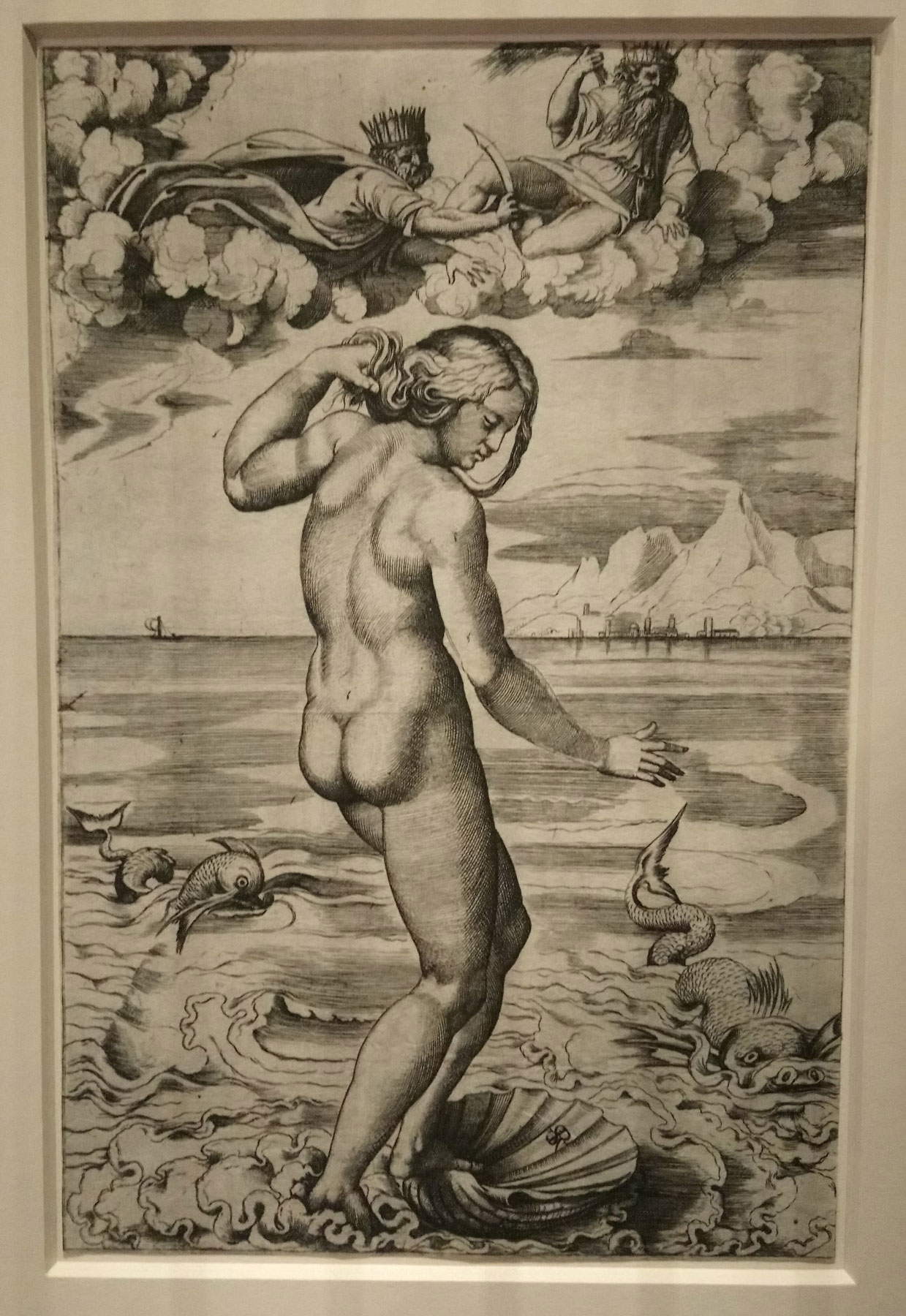 |
| Marco Dente da Ravenna (from Raphael), Venus Anadiomene (c. 1516; burin engraving, 262 x 172 mm; Vienna, Albertina) |
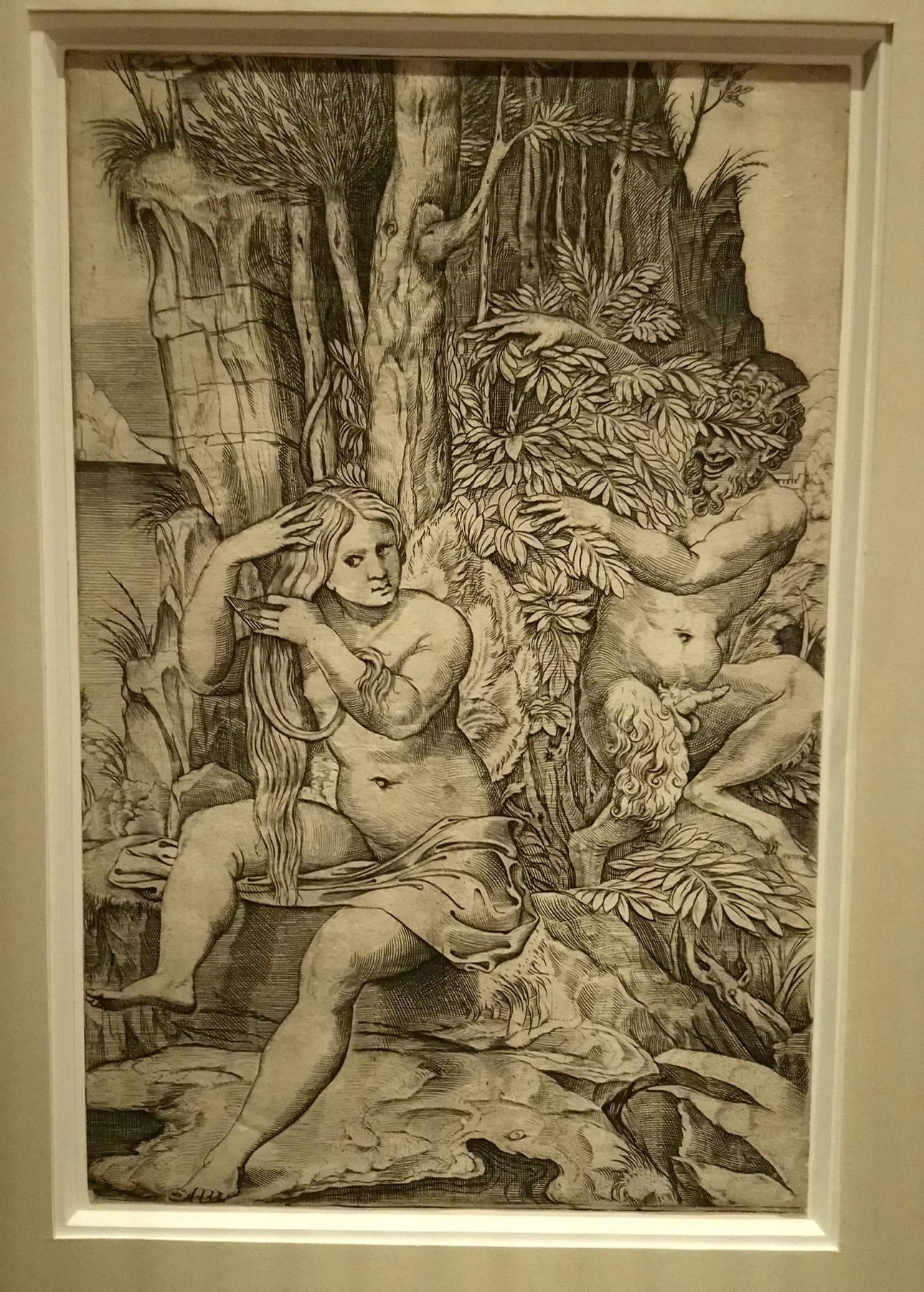 |
| Marco Dente da Ravenna (from Raphael), Venus and a Satyr (c. 1516; burin engraving, 262 x 172 mm; Vienna, Albertina) |
 |
| Attributed to the workshop of Guido Durantino, Plate with Vulcan, Venus, and Cupids with the Coat of Arms of Bishop Giacomo Nordi (c. 1535-1540; majolica, diameter 27.6 cm; Perugia, Fondazione Cassa di Risparmio di Perugia) |
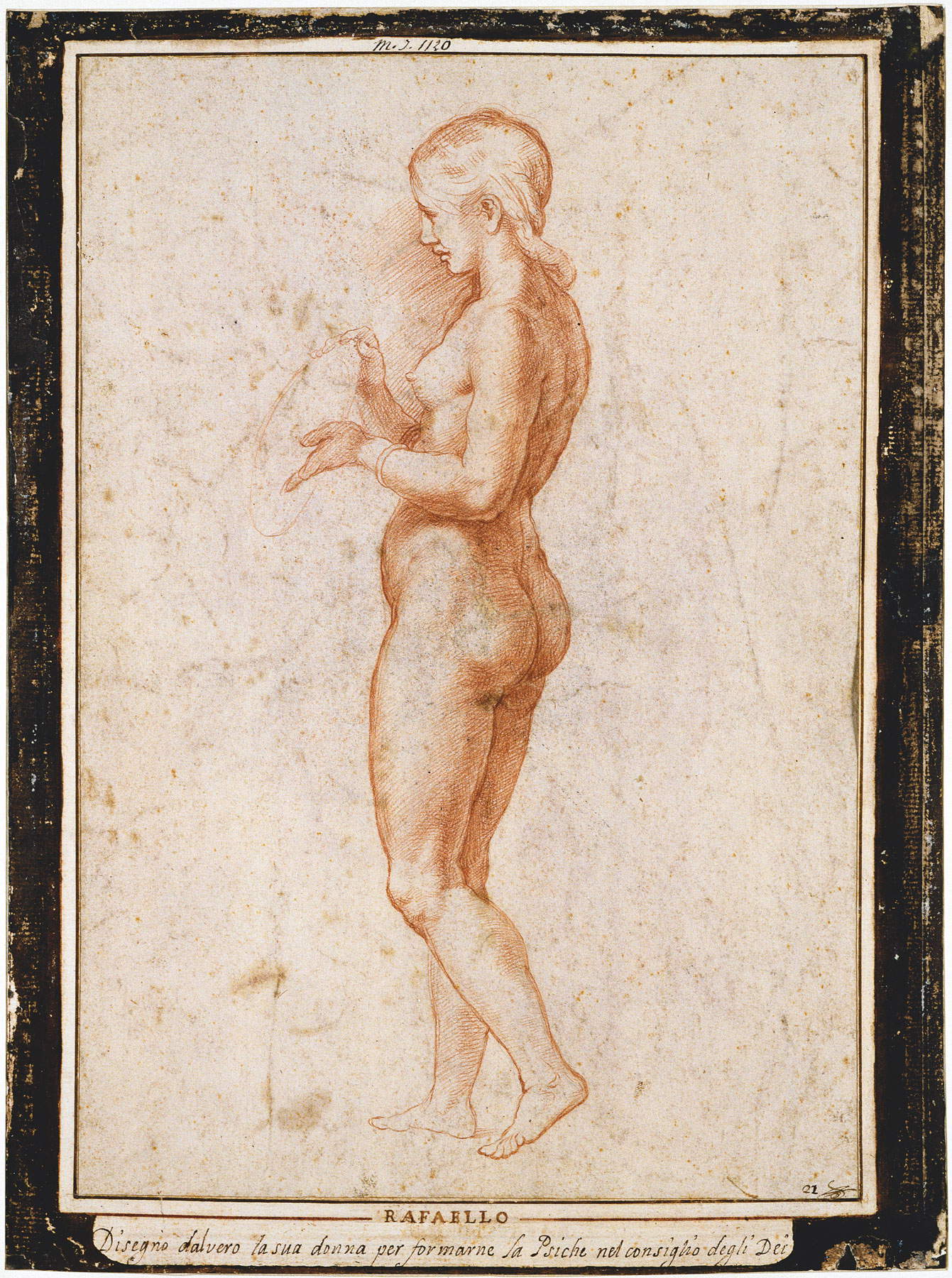 |
| Bottega di Raffaello, Young Female Figure in Profile, verso (c. 1517?; sanguine, 362 x 256 mm; Paris, Musée du Louvre, Cabinet des dessins) |
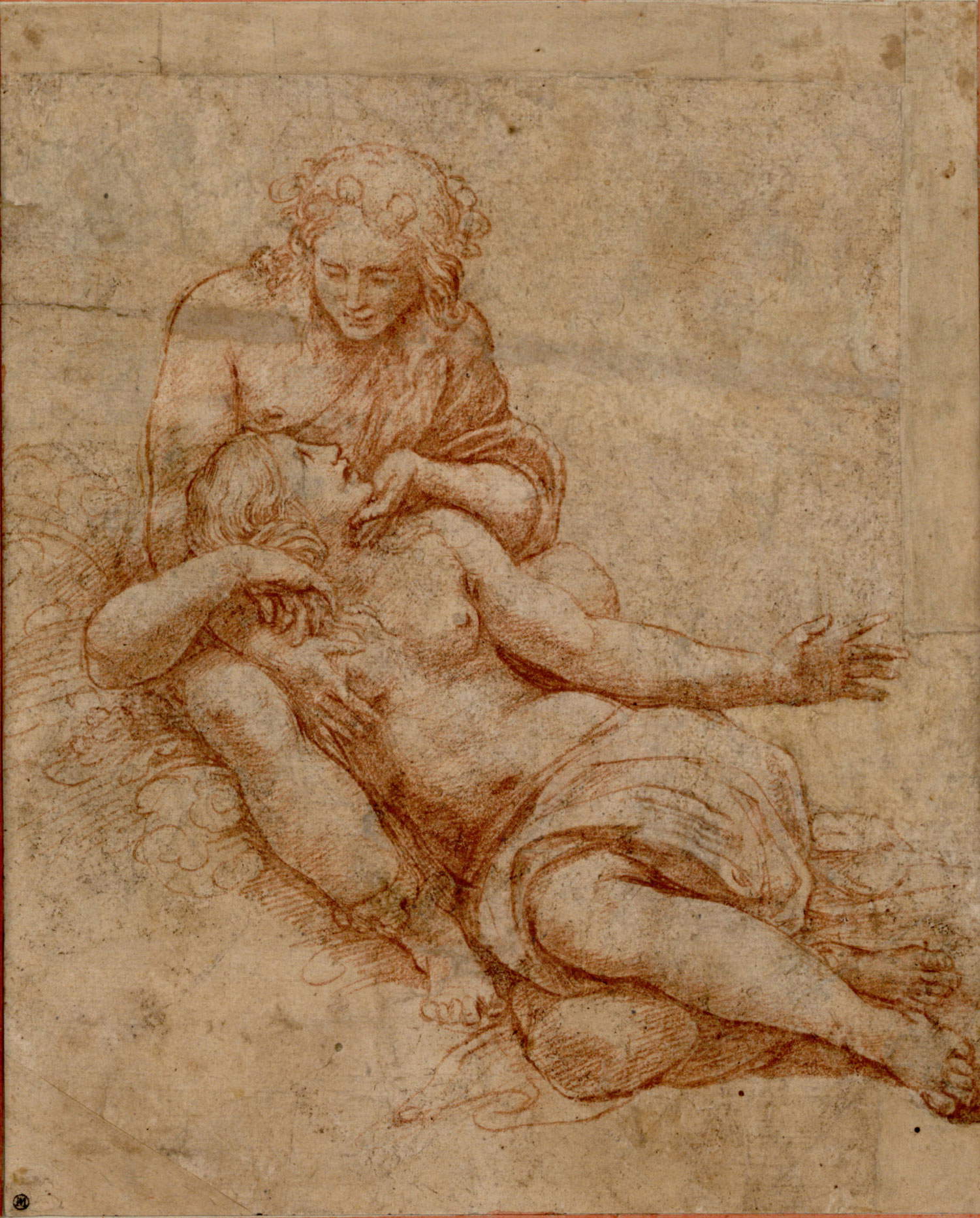 |
| Giulio Romano, Venus and Adonis (1516; sanguine drawing, 224 x 181 mm; Vienna, Albertina) |
To the adventure of the Modi is dedicated (and, for that matter, it could not be otherwise) a substantial section of the Mantuan exhibition. The affair is well known: these are the engravings that Giulio Romano and Marcantonio Raimondi executed around 1524 (Giulio as creator, Raimondi as executor), and which were later “commented on,” between 1527 and 1537, by the verses of Pietro Aretino, later to go down in the history of literature as the Lustful Sonnets. The originals, which went through censorship, do not survive: we know the Modi only through ancient copies and reconstructions. The Modi were nothing more than depictions of sexual intercourse: the exhibition, in addition to pointing out the possible inspiration that Giulio Romano might have drawn from the spintriae, tokens that in ancient Rome were used for payments within the postriboli and which were decorated with erotic scenes (a group of these tokens, from the numismatic collections of the Castello Sforzesco, is on display in the exhibition), provides an interpretation for this singular work that moves away from the traditional associations with pornography (assuming that one can speak of “pornography” in the sixteenth century). The scholar James Grantham Turner, who has long dealt with themes pertaining to eroticism in Renaissance art, prefers to think of the Modes as the “response, by artists of the highest caliber, to the sexual culture of the ancients: their subjects included Cupid, a lascivious satyr, Mars and Venus, and perhaps Leda and the swan, while the compositions constituted witty variants of those found on many objects of ancient workmanship.” Consequently, for Turner the Modes are more a means of expressing virtuosity than inducing excitement.
This is a position that can be debated at length, if one remembers that Vasari, in his Lives, spent strongly negative words on the engravings of Giulio Romano and Raimondi (“fece dopo queste cose Giulio Romano in venti fogli intagliare da Marcantonio, in quanti diversi modi, attitudini e positure giacciono i disonesti uomini con le donne, e, che fu peggio, in each way did Messer Pietro Aretino make a most dishonest sonnet, in such a way that I do not know which was more, or uglier the spectacle of Giulio’s drawings to the eye, or Aretino’s words to the ears.”), and all the more so because the medium of printing, by its very nature (as, moreover, the captions of the room themselves recall), produced works that spread uncontrollably. It is no coincidence that a student of Giulio Romano, Giovanni Battista Scultori, in preparing a print reproducing the very famous fresco of Jupiter and Olympias in the Chamber of Psyche in Palazzo Te, preferred to conceal the god’s phallus. The point lies in understanding what is meant by “pornography,” since an unambiguous definition, especially when applied to a cultural product of the Renaissance, is difficult to find: Bette Talvacchia, a scholar of erotic art at the time, has written that "we cannot cheerfully apply our discourses on pornography to the Modi, because it would mean transferring our values and evaluations onto them, to the detriment of trying to reconstruct the reception of the prints by Vasari and his contemporaries and trying to understand more about the conventions that might have been considered transgressive at the time." One can agree more with Turner when the scholar asserts that the Modi are “an expression of that unique moment when certain Renaissance artists, in specific contexts, set aside the taboo of explicit representation of the sexual act and emotions: all human passions could (and for intellectuals like Aretino should) be captured with the elegant and powerful body language inherited from classical sculpture.”
If, therefore, the exhibition struggles a little too much with the contextualization of the Modi, it picks up with the rest of the room, all devoted to the more lighthearted, ironic, explicit and gleeful depiction of coitus. It winks at contemporary audiences in adopting the anachronism “dildo” to refer to the toy with which a female figure is amused by a female figure leaning on an erma, and caught in the act of masturbating with a fake phallus: the work, an engraving by Marcantonio Raimondi, reflects interest in a subject that is still silenced today, that of female masturbation, but which had already met the curiosity of Pietro Aretino and other authors at the time. We move from solitary to paired sex with an acrobatic copulation between a satyr and a satyr in a goliardic bronze attributed to Desiderio da Firenze (documented in Padua from 1532 to 1545): a singular sculpture where ancient sources (depictions of satyrs from bas-reliefs, sarcophagi and various works decorated with erotic scenes: the exhibition itself offers an example of this with a celebrated marble relief from Pompeii and now in the National Archaeological Museum in Naples) meets modern ones, as it is speculated that the author of this work may have looked to the same Modi as Giulio Romano. In the opinion of curator Guido Rebecchini, a drawing with Two Lovers is also to be traced back to the Modi enterprise (tone and taste are akin to those of the Modi, as in the famous engravings there is a lack of details to identify the two protagonists with some ancient deity, there is irony in the pairing of an old man with a beautiful girl), executed on squared paper (a detail that leads us to suppose that it is a preparatory drawing for a painting or a print) and which is concerned, rather than showing the act itself, with “emphasizing the pleasure of the senses, particularly touch and sight,” the curator points out. And again, among the most curious works in the section is a Refreshment Bowl with the Loves of the Sea Gods, a majolica work by Francesco Durantino (Urbania, c. 1520 - c. 1597) that reinterprets in a distinctly carnal key the fantasies of sea gods in vogue at the time, painting on the ceramic a kind of great orgy among the waves.
 |
| Copy (mirror) from Marcantonio Raimondi (c. 1480-1534) from position 9 of I Modi, numbered II (1530-1540; burin engraving, 134 x 188 mm; Vienna, Albertina) |
 |
| Roman production, Spintriae, triumphal tesserae with erotic scenes (first half of the 1st century AD; brass tesserae, c. 20 mm diameter; Milan, Castello Sforzesco, Numismatic Cabinet and Medagliere) |
 |
| Marcantonio Raimondi, Female figure with dildo (c. 1520; burin engraving, 141 x 70 mm; Stockholm, Nationalmuseum) |
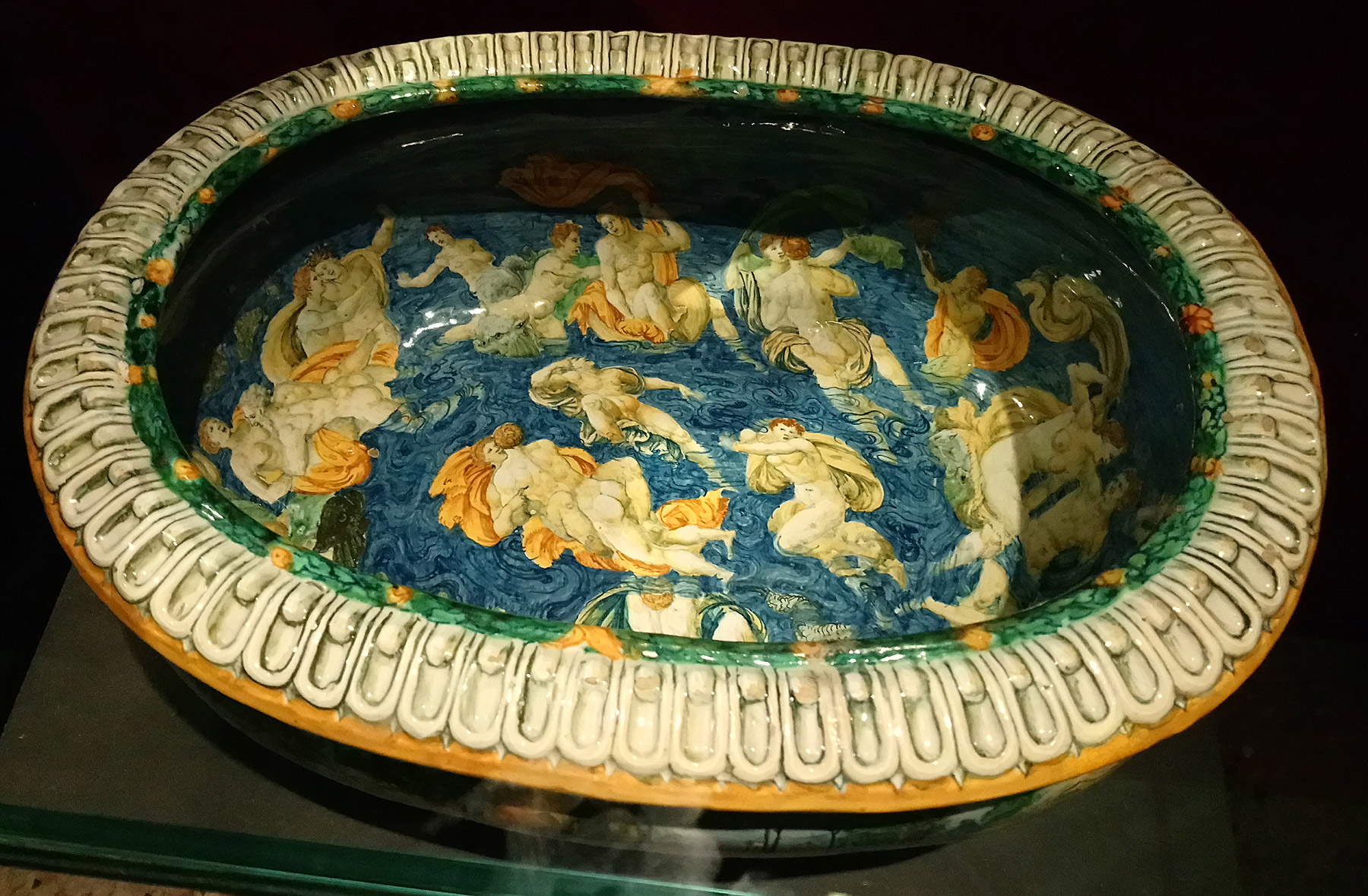 |
| Francesco Durantino, Refreshment Bowl with the Loves of the Sea Gods (1549; majolica, 20 x 35.5 cm, diameter 48 cm; Florence, Museo Nazionale del Bargello) |
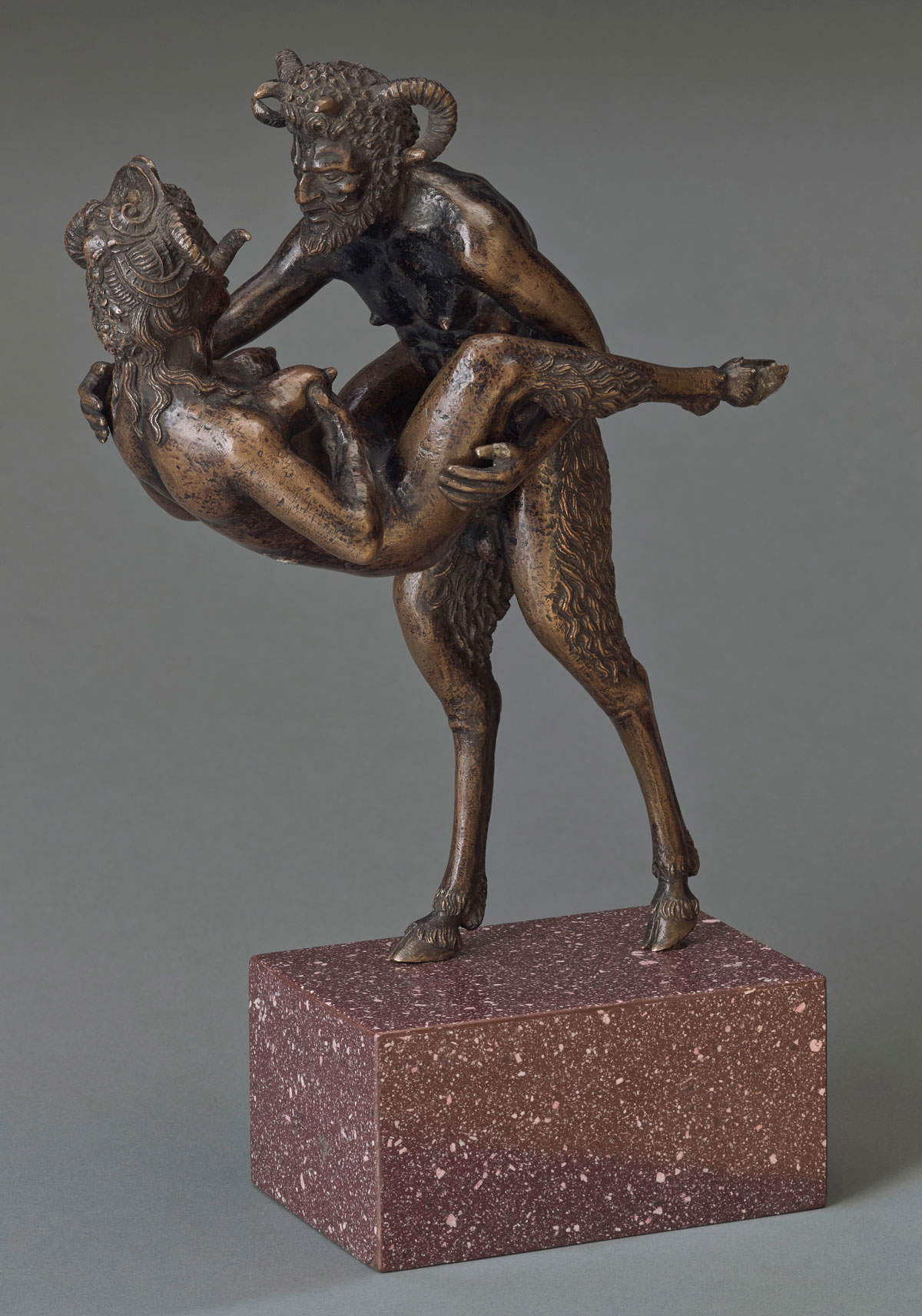 |
| Desiderio da Firenze (attributed to), Satyr and Satress (c. 1530-1540; bronze casting, c. 1530-1540; Ecouen, Musée National de la Renaissance) |
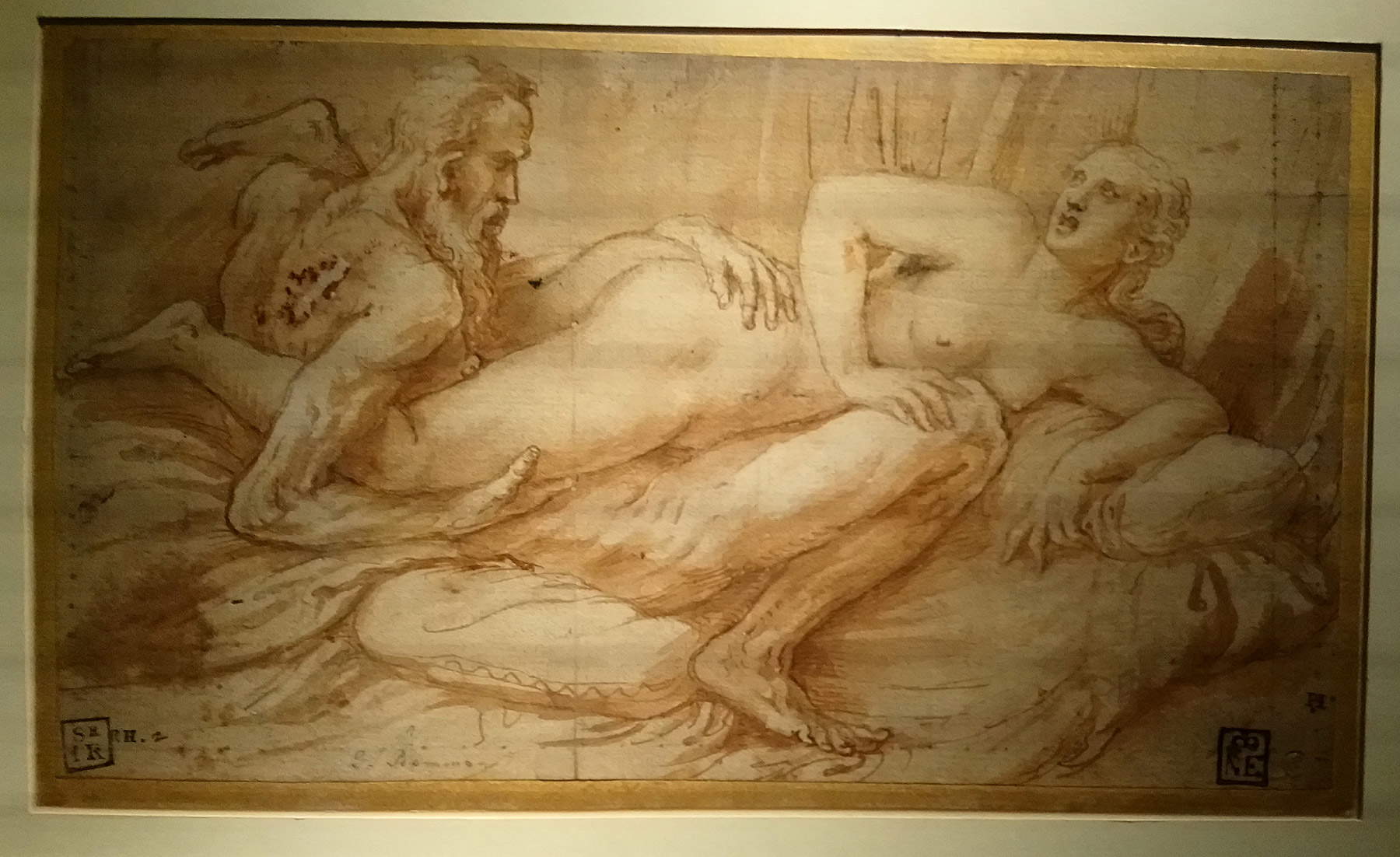 |
| Giulio Romano, Two Lovers (c. 1525-1528; pen, ink, charcoal on paper, 130 x 226 mm; Budapest, Szépmúveszéti Múzeum) |
 |
| Roman Art, Relief with Erotic Scene (c. 50 AD; marble, 35 x 33 cm; Naples, National Archaeological Museum, Secret Cabinet) |
After a first section in which the theme of ancient sources is introduced, the relations between eroticism and cultured circles are explored and the trends that were the basis of erotic art in the sixteenth century are outlined in brief, and a second in which the protagonist is sex as a physical act, as pleasure and as an amusing subject on which one can even joke, with the third section we return to Raphael’s workshop and dwell on a theme closely related to eroticism, that of seduction, which in turn implies further reflections, especially when the exhibition makes use of the example of the Fornarina, shown to the public in a fine copy attributed to Raffaellino del Colle (Sansepolcro, 1495 - 1566), and exhibited alongside Giulio Romano’s Portrait of a Courtesan, a more quotidian and earthy reinterpretation of Raphael’s prototype. Leaving aside the well-known story of the Fornarina (which has already been discussed extensively in these pages), and leaving aside its possible romantic implications, one can look at the work for what it is in its essence: the portrait of an object of desire, the image of a woman who, contrary to Turner’s assertions about the Modi, was probably born to ignite the viewer with passion. Raphael, probably, was aware of the considerations of Leonardo da Vinci, who considered painting superior to poetry because of its ability to be more ready to arouse the cravings of the beholder (“if the poet says to make men kindle to love,” the Tuscan genius wrote in his Treatise on Painting, “it is a principal thing of the species of all animals. The painter has power to do the same, and the more so, that he sets before the lover his own effigy of the thing loved, who often does with that by kissing it and speaking to it what he would not do with the same beauties, set before it by the writer. And all the more exceeds the wits of men to love and fall in love with painting, which represents no living woman.”) If Raphael is among the first artists (along with the Venetians, who are, however, absent from the exhibition: the focus at Palazzo Te is centered exclusively on the Rome-Mantova axis) to play on the thread of the relationship between desire and seduction, between sensuality and ideal drives (it will be worth mentioning in this regard that there are scholars who read the Fornarina as the Petrarchan allegory of an imagined woman: a kind of poetry in the form of painting), Giulio Romano goes further, stripping his Cortigiana of any ethereal afflatus: here, we spectators are nothing more than voyeurs who creep into the room of a high-class prostitute to devour her with their eyes before she gives herself away.
A further jolt is inflicted by the exhibition’s cornerstone, Giulio Romano’s canvas of Two Lovers, restored for the occasion. Here, too, the protagonists are unidentifiable: the painter depicts a foreplay session in a sumptuous alcove, and one would almost come to think of romantic love, were it not for certain details that contribute to giving the scene a strongly sarcastic tone (the old woman who enters from the room to peek at the couple, the depictions of animalistic couplings of satyrs on the bed decorations). Not to mention that we are in the dimension of the most extreme voyeurism, since the two lovers do not know that they are being watched. It is, in short, a painting designed to ensure pleasure or, in the words of curator Barbara Furlotti, “designed to be savored at length and without guilt.” The painting’s patron must have been a high-ranking personage, and documentary discoveries by Sergei Androsov, Aleksej Nicol’skij and Andrej Cvetkov, which emerged precisely on the occasion of the exhibition (a document was found according to which the work, until the 1770s, was part of the collections of the Spanish royal family), have helped shed new light on the story of the Two Lovers: following Furlotti’s reconstruction, the painting was probably commissioned by Federico Gonzaga before Giulio Romano moved to Mantua, in 1524 (it is worth remembering that no documents have remained attesting to the name of the author of the Two Lovers, nor that of the commissioner). The work preserved at the Hermitage could in fact be matched with the “young man and a young woman embraced together above a bed, in the act of caressing each other, while an old woman behind a doorway secretly watches them” that Vasari describes in the collection of Vespasiano Gonzaga, Federico’s relative (although it was perhaps Federico’s brother, Cardinal Ercole Gonzaga, who donated the work to Vespasiano). The work would later be bequeathed to Vespasiano’s daughter Isabella, who went on to marry Prince Luigi Carafa: the large canvas would then have made its way to Naples to join the collection of Anna Carafa, niece of Luigi and Isabella Gonzaga (the inventory of the collection, drawn up in 1641, lists a painting whose description is compatible with the image of the Two Lovers), and wife of Ramiro Núñez Felípez de Guzmán, duke of Medina de las Torres and viceroy of Naples between 1637 and 1644 (the painting may therefore have come to Spain as a gift from the duke to the royal family). Somehow acquiring it from the Spanish royal family was the great painter Anton Raphael Mengs, who brought the work back to Italy (we learn this from unpublished documents published by the three Russian scholars), to Rome, where it was purchased by Catherine II of Russia, who took it to St. Petersburg, from where the canvas has never moved since.
A natural conclusion to the Mantua exhibition is a section devoted to the loves of the gods, which at the time was perhaps the favorite pretext for artists to paint tasty sex scenes. Prominent among them is the cycle conceived by Perin del Vaga (Piero di Giovanni Bonaccorsi; Florence, 1501 - Rome, 1547) and translated by Giovanni Jacopo Caraglio (Verona, 1500 - Parma, 1565) into engravings akin to the Modi, given their variety of positions and their propensity to expose genitals unfiltered (see, for example, the print with Mercury, Aglaurus and Erse, one of the most explicit in the series, with the goddess Erse lying without bothering too much to spread her legs properly), but less likely to scandalize, given that the authors presented them with the intention of illustrating some ancient myths (in addition, it should be added that Perin del Vaga and Caraglio did not have the additional problem of obscene sonnets to comment on them). If the Sleeping Cupid by an anonymous sixteenth-century Roman sculptor is loaded with allegorical references (the pains caused by love, the swiftness of this feeling, and so on), two famous masterpieces such as Leda and the Swan taken from Michelangelo, here in the drawing made by Rosso Fiorentino (Giovanni Battista di Jacopo; Florence, 1494 - Fontainebleau, 1540), and Correggio ’s Danae (Antonio Allegri; Correggio, 1489 - 1534), provide the exhibition with an epilogue of the highest order as among the highest texts of eroticism in 16th-century art: on the one hand, an admirable Michelangelo invention that underscores the erotic dimension of the mythological tale with only the movement of Leda’s powerful body, and on the other, a masterpiece of refinement, joy, and delicacy that, along with the other works in the cycle of the Loves of the Gods that Correggio painted in the early 1430s, ranks among the pinnacles of erotic painting of all time.
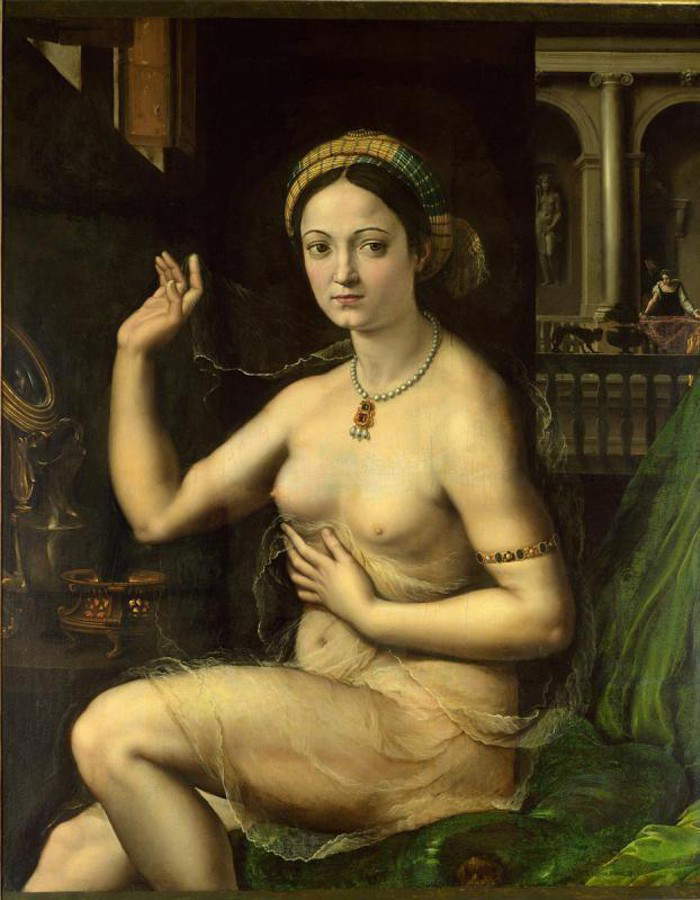 |
| Giulio Romano, Portrait of a Courtesan (c. 1521-1522; oil on canvas, 111 x 92 cm; Moscow, Pushkin Museum) |
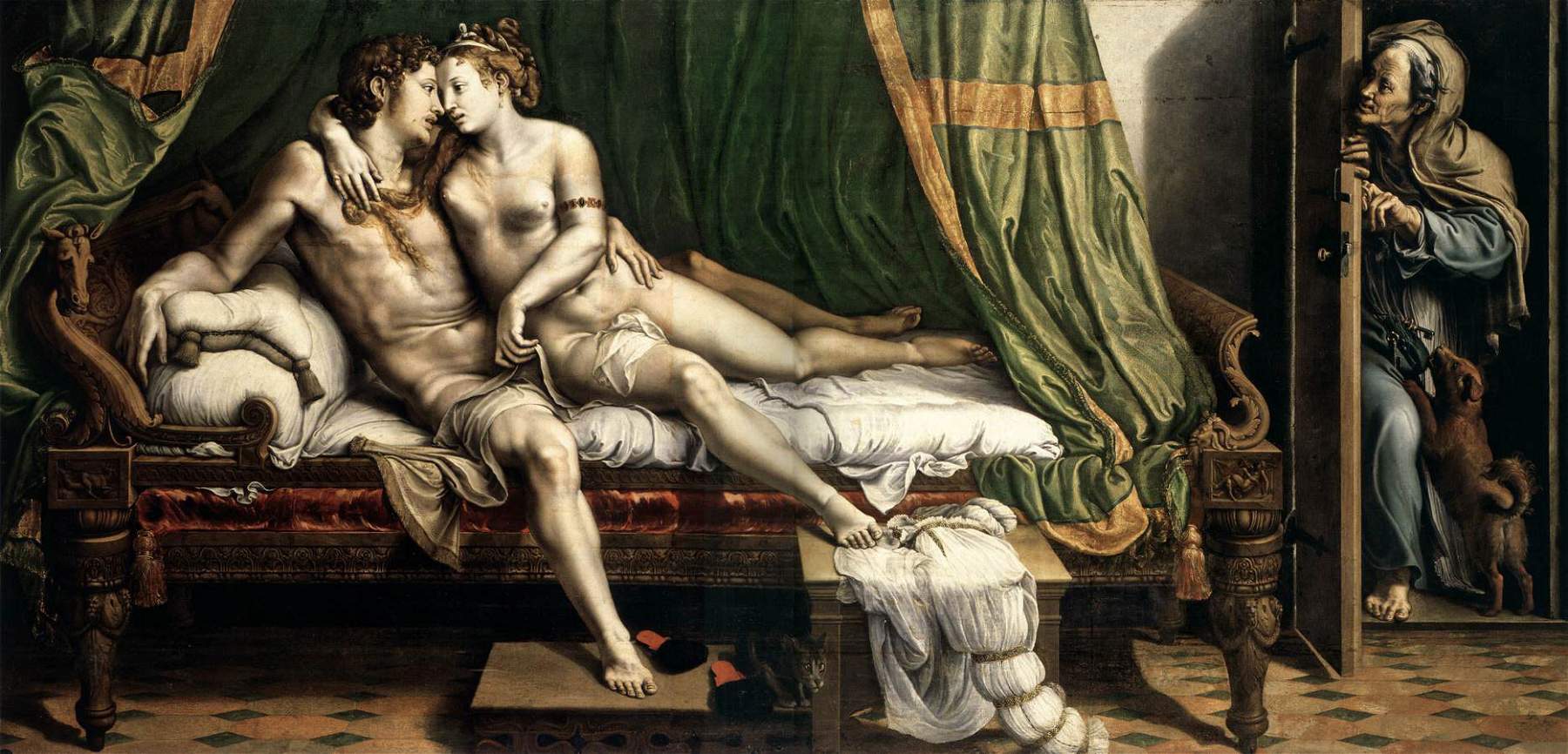 |
| Giulio Romano, Two Lovers (c. 1524; oil on panel transferred to canvas; 163 x 337 cm; St. Petersburg, Hermitage) |
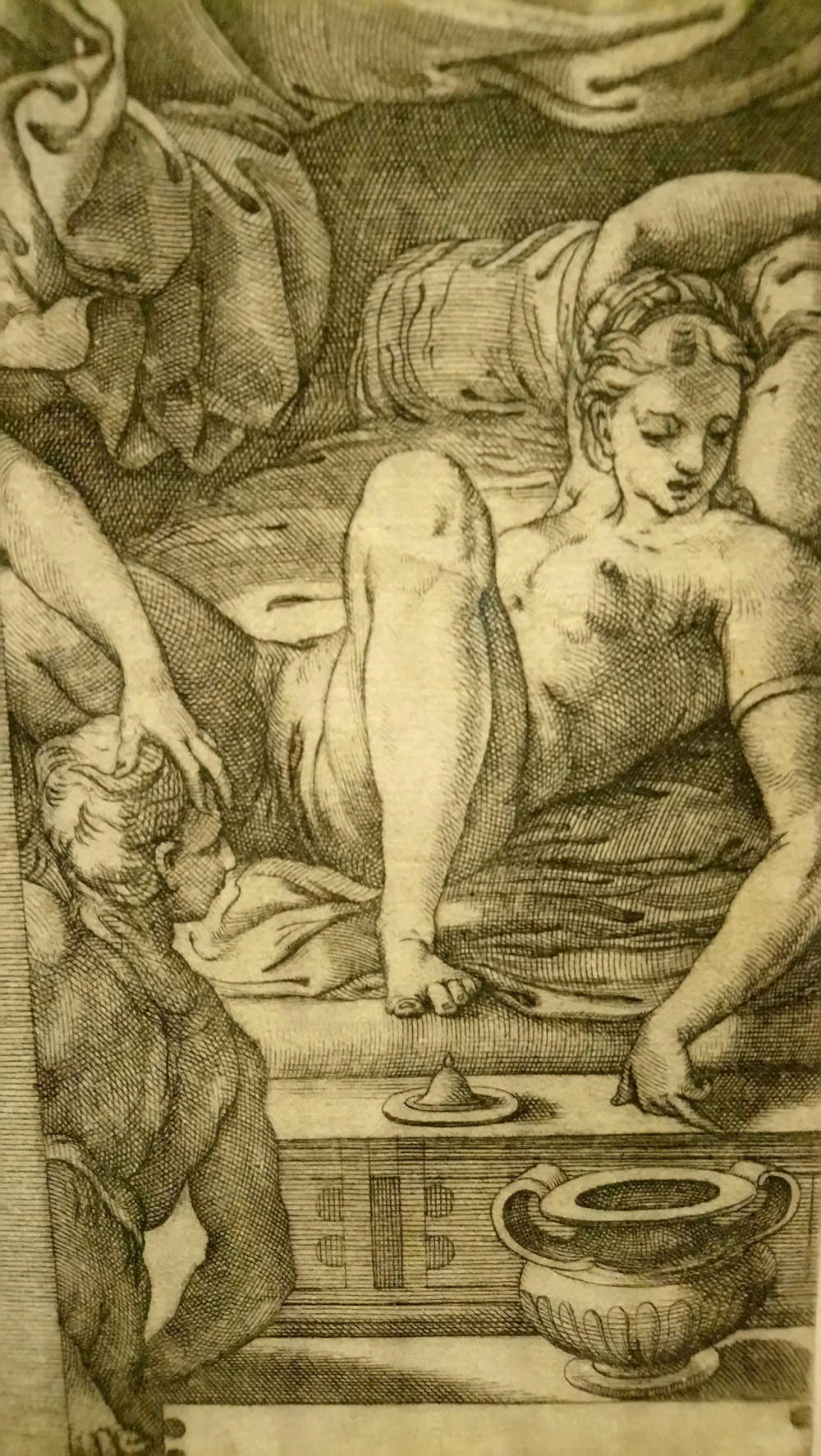 |
| Giovanni Jacopo Caraglio da Perin del Vaga, Mercury, Aglaurus and Erse, detail (c. 1527; burin engraving, 211 x 134 mm; Amsterdam, Rijksmuseum) |
| <img src=’https://cdn.finestresullarte.info/rivista/immagini/2019/1182/rosso-fiorentino-leda-cigno.jpg ’ alt=“Attributed to Rosso Fiorentino (from <a href=”https://www.finestresullarte.info/arte-base/michelangelo-la-vita-le-opere-i-capolavori“>Michelangelo Buonarroti</a>), Leda and the Swan, (1530-1540?; charcoal drawing, 1745 �? 2538 mm; London, Royal Academy of Arts) ” title=“Attributed to Rosso Fiorentino (from Michelangelo Buonarroti), Leda and the Swan, (1530-1540?; charcoal drawing, 1745 �? 2538 mm; London, Royal Academy of Arts) ” /> |
| Attributed to Rosso Fiorentino (by Michelangelo Buonarroti), Leda and the Swan, (1530-1540?; charcoal drawing, 1745 �? 2538 mm; London, Royal Academy of Arts) |
 |
| Antonio Allegri known as Correggio, Jupiter and Danae (1530-1532; oil on canvas, 161 �? 193 cm; Rome, Galleria Borghese) |
In the narrative of the Mantua exhibition, the suggestions of which a summary has been provided above are continuously interwoven, intersecting on different planes and concurring to form a path that, while limited in time and space (there can be no claim to provide a complete picture of eroticism in 16th-century art: we therefore limit ourselves to recounting what was going on in Giulio Romano’sentourage in Mantua and what its prodromes were in Raphael’s workshop in Rome), offers the public an accurate picture of an often overlooked reality, namely the fact that the representation of sex, in the words of Bette Talvacchia, was part of the cultural production of the Renaissance, and its historical weight is not all that different from that of other topics that historiography has scrutinized better and in greater depth ( gender studies on the Renaissance have long remained, and largely still remain, a prerogative of the Anglo-Saxon world). The exhibition is able to meet and satisfy the expectations of the general public, thanks to an extremely passionate exhibition itinerary, to a selection capable of narrating and provoking at the same time, to a rigorous, methodical scansion and made engaging by a layout, curated by Piero Lissoni and Gianni Fiore, that is clean, clear, restful and elegant: it is nevertheless necessary to emphasize how, at the end of the visit, two knots remain more outstanding than others (material for future exhibition occasions?).
The first concerns Raphael’s workshop: to Giulio Romano. Art and Desire deserves credit for emphasizing the importance of the Urbino painter also in relation to themes oferos (the crystalline, almost metaphysical aura that is often attributed to him is thus rightly dispelled) and the fact that it was also thanks to Raphael that erotic painting went through a certain degree of diffusion, but we do not perceive any lunge or stance on a theme that is also hinted at in the catalog (in Madeleine Viljoen’s essay): that of the workshop as an “eroticized space,” as defined by James Grantham Turner in his 2013 essay Invention and sexuality in the Raphael workshop, which has gone virtually unnoticed in Italy. The thesis is that Renaissance artists, more or less imbued with classical culture, thinking of the mythological anecdotes of Phryne posing for Praxiteles, of Campaspe posing for Apelles, or of Pygmalion falling in love with the statue he himself sculpted, had been led to think that the workshop was a place that could also be connoted sexually. Evidence of this would be, according to Turner, the well-known affair of the model Catherine who posed for Cellini’s Nymph: the sculptor, in his own autobiography, tells a story of “carnal pleasures” that were needed between posing sessions, but also of violence (Cellini had no qualms about admitting that he beat her). And another scholar, Jill Burke, argued in her 2016 essay that the development of 16th-century erotic art goes hand in hand with the emergence of the role of courtesans. The topic is all in all complex, and it would be interesting to understand how much of an influence the availability of female models (a new fact) actually had on the erotic art production of the time, especially for a time when seeing a nude female body was not as taken for granted as we might consider it today, and consequently could be charged with erotic potential (a humanist of the time, Lodovico Domenichi, recalling some episodes about the use of models by ancient painters in one of his dialogues entitled La nobiltà delle donne (The Nobility of Women), wrote that “io per me bella et leggiadra donna havessi havuto in casa mia, ogni altra cosa più tosto n’harei fatto, che darla in preda a un pretestuoso et temerario artefice, et per aventura giovane et lussurioso: From whom God knows how they returned untouched and inviolate.”).
The second could be a question (of a certain topicality, wanting to put it in relation to gender studies): what really was sex in Giulio Romano’s time? How much did the images reflect what used to happen in reality? How were men and women supposed to behave in bed according to the social norms of the time? To try to answer this question, one could start with a topic that is well developed in the catalog (in a timely essay by Barbara Furlotti), but little touched on in the exhibition: the relationship between power and images of sex in Palazzo Te. Having discarded the old interpretations of the building as an exclusive place of pleasure, its function finally seems clear to us (most recently summarized by Stefano L’Occaso in his new book Giulio Romano “universal”): Federico II Gonzaga thought of it as a sort of “delizia” (“neither residence nor fortress,” Gombrich wrote about Palazzo Te), an extra-urban villa conceived both as a public space (remember that these rooms also hosted the emperor Charles V, who elevated Federico to duke in 1530) and as a private space intended for the sovereign’sotium, rest, and meetings with his mistress Isabella Boschetti (which, however, had little secret about them, since the relationship is even mentioned in official documents). In this context, the most eroticized space, that of Psyche’s Chamber, was part of the wing reserved for Frederick, and had a sort of dual function, halfway between drawing room and dining room (the banquet for Charles V, for example, was set up in this room). In her contribution, Furlotti espouses the conviction of Maria Maurer who, in a book released this year(Gender, Space and Experience at the Renaissance Court) states that “when Frederick and his male guests gathered in the Chamber of Psyche, the sumptuous and eroticizing decorations of the room facilitated homosocial bonds, allowing them to identify themselves as rational and virile agents acting in accordance with well-established gender norms.”
Norms that, for example, we find in Baldassarre Castiglione’s The Courtier, when he advised the courtier to be “exercised in writing verse, and prose [...], that, besides the contentment that he himself will take, by this means he will never lack pleasant intertentions with women, who ordinarily love such things,” or to the woman “who lives in the court” to be endowed with a “certain pleasant affability, by which she knows how to kindly intertend all sorts of men with reasonings grateful, and honest, and accommodated to the time, and place, and to the quality of that person with whom she will speak; accompanying with her placid, and modest manners, and with that honesty which always has to compose all her actions, a ready vivacity of wit,” or when she maintained that women “alone lift from our hearts all the vile and low thoughts, the afflictions, the miseries, and those turbid sadnesses which so often are their companions” and [....] “to war make men fearless and bold above manner,” since according to Castiglione’s conception it was impossible that “in the heart of a man in whom a flame of love has once entered, ever more cowardice reigns; for he who loves, always desires to make himself as lovable as he can, and always fears lest some shame should occur to him that might make him’ esteem himself little by him who he desires to be esteemed much.” Women, in essence, in addition to being expected to give an image of modesty and chastity, would have preferred easy and light conversations (so much so that often, in the Courtier, the female protagonists interrupt the discussions when they become more complicated), leaving men the domain of philosophy, politics, and, of course, military virtues, which were all the greater the more the man was able to love and be loved. Thus, while the erotic images provide a way to exalt the virility of its patron and his abilities as a lover and, consequently, as a man of arms and politician, they also offer clear examples of what women were not supposed to be in accordance with the morals of the time: that is, they were not supposed to “follow their love interests if someone else objected,” Maurer reiterates. And it is perhaps in Psyche’s Chamber that the conception of sex in the sixteenth century is best understood: on the one hand the strength and initiative of the male, on the other the extreme passivity of the woman.
Warning: the translation into English of the original Italian article was created using automatic tools. We undertake to review all articles, but we do not guarantee the total absence of inaccuracies in the translation due to the program. You can find the original by clicking on the ITA button. If you find any mistake,please contact us.